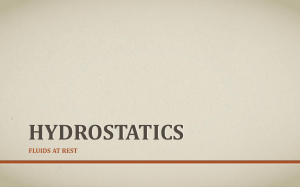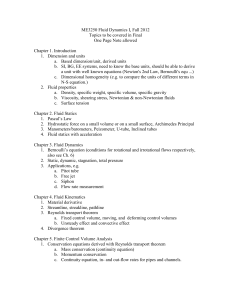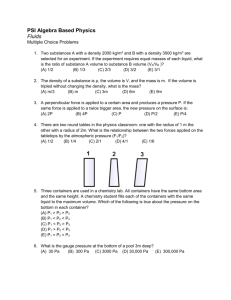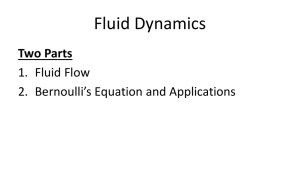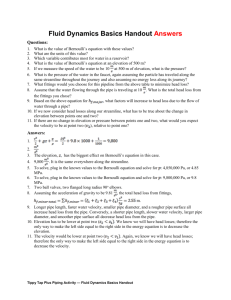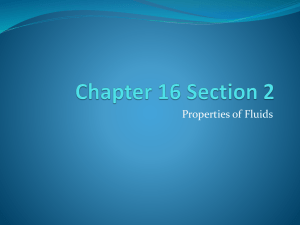Fluid Mechanics Define: Density: similar to the way mass was very
advertisement
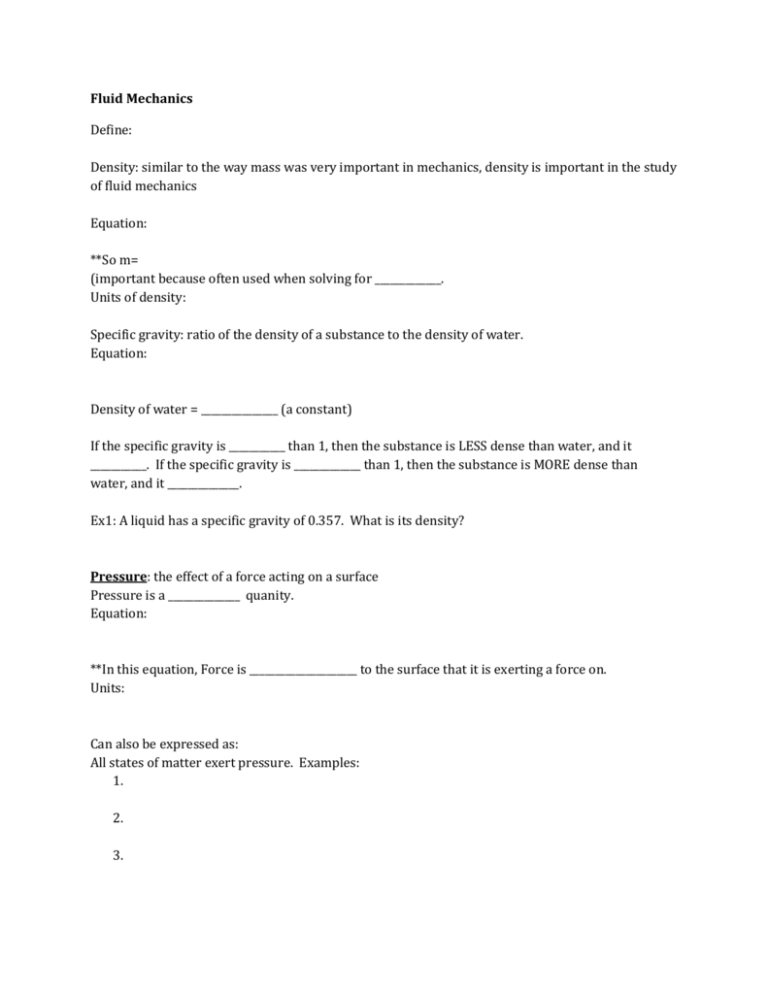
Fluid Mechanics Define: Density: similar to the way mass was very important in mechanics, density is important in the study of fluid mechanics Equation: **So m= (important because often used when solving for _____________. Units of density: Specific gravity: ratio of the density of a substance to the density of water. Equation: Density of water = _______________ (a constant) If the specific gravity is ___________ than 1, then the substance is LESS dense than water, and it ___________. If the specific gravity is _____________ than 1, then the substance is MORE dense than water, and it ______________. Ex1: A liquid has a specific gravity of 0.357. What is its density? Pressure: the effect of a force acting on a surface Pressure is a ______________ quanity. Equation: **In this equation, Force is _____________________ to the surface that it is exerting a force on. Units: Can also be expressed as: All states of matter exert pressure. Examples: 1. 2. 3. Ex2: A driveway is 22.0 m long and 5.0 m wide. If the atmospheric pressure is 1.0 x 105 Pa, How much force does the atmosphere exert on the driveway? Ex3: A vertical force of 30 N is applied uniformly to a flat button with a radius of 1 cm that is lying on a table. Which of the following is the best order of magnitude estimate for the pressure applied to the button? (A) 10 Pa (B) 102 Pa (C) 103 Pa (D) 104Pa (E) 105 Pa Hydrostatic Pressure: pressure in a liquid (or gas) at rest Determining an equation for Pressure of a liquid (or gas) using what we know about Newton’s Second Law: **Please note: this equation depends only on density of the liquid/gas and the depth of the object below the surface What doesn’t the pressure of the liquid/gas depend on? If an object in the liquid is in a vacuum (with no atmosphere surrounding it), then this pressure is the only pressure that needs to be accounted for, however, more often, the fluid/object are exposed to air, and so the equation for the absolute pressure of the system is: The pressure of the liquid (or gas other than air) is called the_____________ pressure Graph Pressure vs depth for both gauge pressure and absolute pressure: Ex4: If the gauge pressure of a device reads 2.026x105 N/m2, what is the absolute pressure? Pascal’s Principle: when a force is applied to a contained incompressible fluid (means that in the fluid the ___________ does not change as the distance below the surface increases), the pressure increases equally in all directions throughout the fluid Examples in real life: 1. 2. 3. **This is the foundation for ________________________ systems. Can increase or decrease force by changing the area…for conservation of energy, have to push piston further so that total work is the same on either side Ex5: A barber raises his customer’s chair by applying a force of 150N to a hydraulic piston of area 0.01m2. If the chair is attached to a piston of area 0.1m2, how massive a customer can the chair raise? ( Assume that the chair has a mass of 5Kg) Ex6: A rectangular object with a density of 2000 Kg/m3 has a base area of 1.0m2. If the height of the rectangle was 3m, how much pressure does the object exert on the ground? Ex7: A 500 N weight sits on the small piston of a hydraulic machine. The small piston has an area of 2 cm2 . If the large piston has an area of 40 cm2, how much weight can the large piston support? A) 25 N B) 500 N C) 10000 N D) 40000 N Buoyancy If a block is dropped into a tank of water, then the pressure exerted on the block depends on the depth of the block below the surface. At the sides, the pressure is the same, however, when you compare the top of the block to the bottom of the block there is a difference in pressure, why? This is called Buoyancy. Define: Equation (known as Archimedes Principle): If an object FLOATS then buoyant force is equal to _______________ so: Based on this equation: If the density of the object is __________________ than the density of the liquid, the object will float. The ratio of the two also determines the amount of the object which will be submerged in the liquid, the closer to 1, the more of the object that will be submerged. What would a free body diagram of this look like, and what would the sum of the forces be equal to? If the density of the object is __________________ than the density of the liquid, the object will sink. What would the FBD of an object that has sunk to the bottom of an aquarium look like? If the density of the object is ___________________ to the density of the liquid, the object will hover (fully submerged) at equilibrium somewhere in the liquid. What would a free body diagram of this look like, and what would the sum of the forces be equal to? **Again, this can also apply to gases… Ex8: A cork has weight mg and density 25% of water density. A string is tied around the cork and attached to the bottom of a water-filled container. The cork is totally immersed. Express in terms of the cork weight mg, the tension in the string A) 0 B) mg C) 2mg D) 3mg E) 4mg Ex9: Two objects labeled K and L have equal mass but densities 0.95Do and Do, respectively. Each of these objects floats after being thrown into a deep swimming pool. Which is true about the buoyant forces acting on these objects? (A) The buoyant force is greater on Object K since it has a lower density and displaces more water. (B) The buoyant force is greater on Object K since it has lower density and lower density objects always float “higher” in the fluid. (C) The buoyant force is greater on Object L since it is denser than K and therefore “heavier.” (D) The buoyant forces are equal on the objects since they have equal mass. (E) Without knowing the specific gravity of the objects, nothing can be determined. Ex10: The figure shows an object of mass 0.4 kg that is suspended from a scale and submerged in a liquid. If the reading on the scale is 3 N, then the buoyant force that the fluid exerts on the object is most nearly (A) 1.3 N (B) 1.0N (C) 0.75 N (D) 0.33 N (E) 0.25 N Ex11: A large rectangular raft (density 650 kg/m3) is floating on a lake. The surface area of the top of the raft is 8.2 m2 and its volume is 1.80 m3. The density of the lake water is 1000 kg/m3 (a) Calculate the height h of the portion of the raft that is above the surrounding water. (b) Calculate the magnitude of the buoyant force on the raft and state its direction. (c) If the average mass of a person is 75 kg, calculate the maximum number of people that can be on the raft without the top of the raft sinking below the surface of the water. (Assume that the people are evenly distributed on the raft.) We have learned a lot about liquids/gases at rest, what about if they are in motion… Flow rate is the _________________ of fluid that passes through a particular point in a particular amount of time. *Note: this is not the speed at which the liquid is flowing, it’s the _______________. This holds true even as the diameter of the pipe changes = the flow rate remains constant. Equation: If the pipe carrying the fluid is ________________________, which means: Then: **remember, if we are speaking about a pipe, then the area is πr2 so the equation becomes: Ex12: Water enters a garden hose that has a diameter of 1.6cm with a velocity of 3 m/s. Calculate the exit velocity of water from the garden hose when a nozzle of diameter 0.5cm is attached to the end of the hose. Ex13: A river gradually deepens, from a depth of 4 m to a depth of 8 m as shown. The width, W, of the river does not change. At the depth of 4 m, the river’s speed is 12 m/sec. Its velocity at the 8 m depth is (a) 12 m/sec (b) 24 m/sec (c) 6 m/sec (d) 8 m/sec (e) 16 m/sec Ex14: Liquid flows through a 4 cm diameter pipe at 1.0 m/s. There is a 2 cm diameter restriction in the line. What is the velocity in this restriction? A) 0.25 m/s (B) 0.50 m/s (C) 2 m/s (D) 4 m/s Bernoulli’s Equation Conservation of Energy for “IDEAL” fluid flow. Three conditions must be met in order for fluid flow to be ideal: 1. 2. 3. Equation: The next two examples: Refer to the diagram below and use 10 m/s2 for g and 100,000 N/m2 for 1atm. Ex15: The pressure at A is 9.5 atm and the water velocity is 10 m/s. What is the water velocity at point C? (a) 2.5 m/s (b) 5 m/s (c) 10 m/s (d) 20 m/s (e) 40 m/s Ex16:The pressure at C is (a) 0 N/m2 (b) 100,000 N/m2 (c) 150,000 N/m2 (d) 850,000 N/m2 (e) 1,100,000 N/m2 If we had a large open air tank that had a very small hole poked near the bottom of it, calculate the velocity of the water coming out of that hole using Bernoulli’s Equation (called Torricelli’s Theorem)? Bernoulli’s Principle The pressure is _______________ where the flow speed is __________________ . Accounts for many things that are observed everyday: 1. 2. 3. Ex17: An underground pipe carries water of density 1000 kg/m3 point A, 0.50 m below ground level, the pipe has a cross-sectional area of 1.0 x 10-4 m2 to a fountain at ground level, as shown above. At ground level, the pipe has a cross-sectional area of 0.50 x 10-4 m2. The water leaves the pipe at point B at a speed of 8.2 m/s. (a) Calculate the speed of the water in the pipe at point A. (b) Calculate the absolute water pressure in the pipe at point A. (c) Calculate the maximum height above the ground that the water reaches upon leaving the pipe vertically at ground level, assuming air resistance is negligible. (d) Calculate the horizontal distance from the pipe that is reached by water exiting the pipe at 60° from the level ground, assuming air resistance is negligible. Review of what we have learned: Name Variable Density Specific Gravity Pressure Gauge Pressure Total Absolute Pressure Pascal’s Principle Buoyancy Force Flow Rate Continuity Equation Bernoulli’s Equation Units Equation

